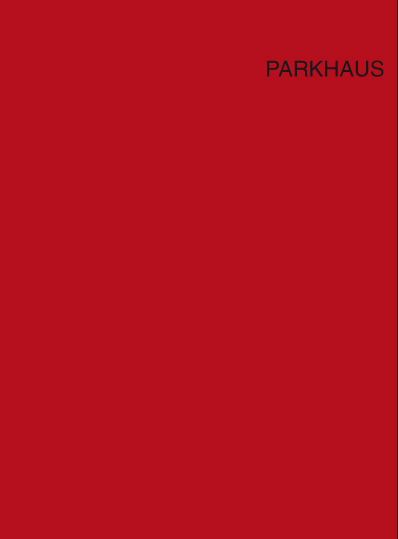Dr. Yvette Deseyve
Reinhold Budde. Parkhaus
Exhibition in the Gartenpavillon
in Malkastenpark Düsseldorf, 2015
One could describe the park of the highly traditional art
society
„
Malkasten“ in Düsseldorf-Pempelfort as idyllic. Here,
the sociopolitical commitment of the artists of Düsseldorf
has been met by a wider public with an interest in art since
1861. One tends rather rapidly to interpret the park with
its historical ensemble of buildings, the Düsselbach (river)
and
„
Venus Pond“ as a suitable framework to a humanistbased
meeting place for artists, philosophers and citizens,
where art and nature appear to merge quite harmoniously. It
may be rather astounding, therefore, to come across a twopart,
functional structure with flat roof and attached pergola
in the eastern part of the garden. Inside it, two identical
sets of rooms run parallel to one another; the layout and
dimensions suggesting the building‘s one-time use as a
double garage with open pergola. Since the redesign of
the garden by Roland Weber in 2009, this former Parkhaus
(car park) has been used as a Haus im Park (house in the
park) and serves as an additional exhibition space for the
Kunstverein Malkasten.
Starting out from painting, Reinhold Budde has
expanded his artistic concept further and further into space
while at the same time increasingly sensitizing his art to a
specific spatial situation. His approach is no longer founded
on occupying a space with his art; instead, it is a matter
of transforming the space. In short, he seeks to create a
coherent art space from the existing spatial continuum he
encounters.
Budde‘s spatial concept is now rooted in his
deliberations on the effect of colour in space. Initially,
his monochrome, flat paintings in the style of Minimalism
developed accentuations of colour on the wall, but with
his „resonance spaces“ he made a decisive turn around.
Flat areas of colour were no longer exhibited directly, but
were made to resonate due to their reflections in front of
the wall. However, with the idea of iridescent resonating
colour spaces, the materiality of colours receded into the
background and their impact came to the fore. Budde does
not aim for the individual expression of painting technique
but seeks to build up colours perfectly in order to develop
a particular effect. It may not seem surprising, therefore,
that in his exhibition at the Malkasten in Düsseldorf the
artist completely ignores the walls and does not hang up
a single picture, but starts out immediately from the spatial
configuration.
Each of the two parcels of space in Düsseldorf is
divided by a deep-coloured curtain. While the intense
red curtain that unfolds plastically still manages to divide
the space symmetrically into two regular triangular forms,
the second division of space radicalizes the entire spatial
configuration of the exhibition complex. Budde‘s deep
black curtain fails to divide the space harmoniously into
two halves with the same form; instead, it focuses on the
transition, the connecting opening in the wall between the
two lots of wall. This
„
transfer area“ is given additional
emphasis by means of two gleaming yellow profiles, which
accentuate the newly created sequence of rooms and
mediate between the two spaces. The observer‘s viewing
axis is manifest quite literally in these raised profiles on the
ground, which point from the darkness of the first space into
the glowing red room which lies beyond. Here, too, we see
the influence of Budde‘s artistic understanding of colour as
a powerfully effective medium beyond its direct materiality;
for the source of the colour, i.e. the red curtain dividing the
space, is not visible initially from the viewer‘s standpoint.
While Reinhold Budde‘s previous exhibitions – examples
one might mention here being the presentation
„
To
Palermo“ in the Gerhard-Marcks-House or his installation
„
Bühne # Raum“ realized in the GaDeWe Bremen – investigated
possibilities of setting the viewer in motion using
colours, the artist radically opposes this approach in his
work in Düsseldorf. The entire exhibition space is closed
to the viewer. Thus, paradoxically, the standard approach
to sculpture and installation – that is, access via one‘s own
bodily experience – is switched off. Reception is reduced
to purely visual insights through a wide range of door and
window openings. In this way Reinhold Budde refers quite
directly, and with a pointed undertone, to the title with which
the Kunstverein Malkasten programmatically underpins the
exhibition space here:
„
Garden Vitrine“. Through its allusion
to a common form of museum presentation, and thus to its
associated assessment and function as a protective space,
the
„
Garden Vitrine“ clearly delineates two separate areas:
here the art space, there the natural space. More than this:
not only is the boundary indicated by the fact that we are
prevented from walking through the exhibition space; far
more, at this point Budde initializes a carefully calculated
system by which he reflects this same boundary.
The open character of the pergola on the long side
of the
„
Garden Vitrine“ lends the structure direct spatial
proximity to a neighbouring building and its front of
windows. Reinhold Budde places mirrors on the three
windows of the neighbouring structure, set out as they are
in a rhythmic sequence. This intervention outside the actual
exhibition space means that it is the interior exhibited in
the
„
Garden Vitrine“ which is reflected, while the actual
view through the windows themselves is blocked. With his
work at the
„
Garden Vitrine“ of the Kunstverein Malkasten,
artist Reinhold Budde stages the boundary highlighted in
the exhibition series
„
Inside/Outside“ as a complex play
of viewing axes and observational standpoints. Budde
permits only insights from the outside in, but at the same
time he shows the interior in external space and positions
the actual viewing perspective in the exact area between
the art space and the natural space.
